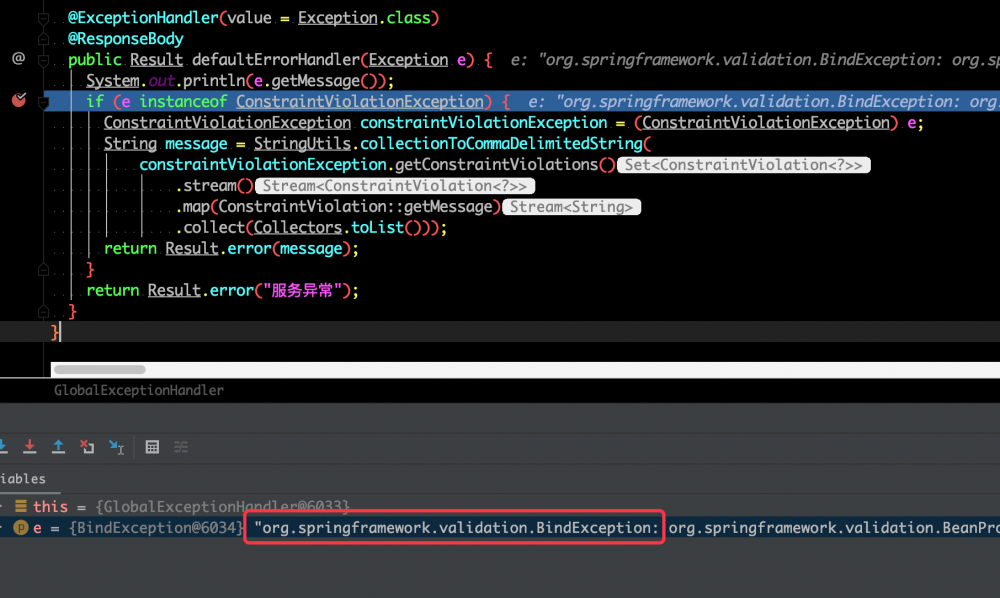springboot前后端分离项目中使用hibernate-validator校验请求参数返回自定义异常信息的json数据
之间整理过一篇 springboot 项目里使用 hibernate-validator 校验参数,然后在freemarker模板里取异常信息展示 的博客
现在都流行前后端分离了,服务端大都直接返json,又稍微折腾了一下,结合统一异常处理, 优雅的实现请求参数的校验
创建项目
这个不多说,引入一个依赖即可
<dependency>
<groupId>org.hibernate.validator</groupId>
<artifactId>hibernate-validator</artifactId>
<version>6.0.17.Final</version>
</dependency>
简单使用
使用 hibernate-validator 分两步
@Validated @NotNull
简单例子
import com.example.hibernatevalidator.util.Result;
import org.springframework.validation.annotation.Validated;
import org.springframework.web.bind.annotation.GetMapping;
import org.springframework.web.bind.annotation.RequestMapping;
import org.springframework.web.bind.annotation.RestController;
import javax.validation.constraints.NotNull;
/**
* Created by tomoya at 2019/9/11
*/
@RestController
@RequestMapping("/")
@Validated
public class IndexController {
@GetMapping("/index")
public Object index(@NotNull(message = "姓名不能为空") String name) {
return Result.success("你好," + name);
}
}
可以看到 @NotNull 注解是 javax.validation.constraints 这个包下的,后面介绍的一些校验注解都是这个包下的,可见hibernate-validator是实现的java的api
然后启动项目,浏览器访问 http://localhost:8080/index 可以看到出现了下面这个错误页面

这个页面是springboot内置的错误页面
项目都前后端分离了,错误信息肯定最好也用json返回了,其实这时候如果用postman这样的工具来访问这个接口返回的就是一段json,长下面这个样
{
"timestamp": "2019-09-11T07:42:56.703+0000",
"status": 500,
"error": "Internal Server Error",
"message": "index.name: 姓名不能为空",
"path": "/index"
}
就算是这个样也不是我想要的,项目里封装了一个类,专门返回json的,长这个样
public class Result {
private int code;
private String description;
private Object detail;
public static Result success(Object detail) {
Result result = new Result();
result.setCode(200);
result.setDetail(detail);
return result;
}
public static Result error(String description) {
Result result = new Result();
result.setCode(201);
result.setDescription(description);
return result;
}
// getter setter
}
怎么才能让hibernate-validator校验的异常信息以自己定义的类的格式返回呢?这就要用到统一异常处理了
链接文原: https://tomoya92.github.io/2019/09/11/spring-boot-hibernate-validator-json/
统一异常处理
springmvc是相当的强大的,只需要两个注解就能使用统一异常处理 @ControllerAdvice 外加上 @ExceptionHandler
import com.example.hibernatevalidator.util.Result;
import org.springframework.web.bind.annotation.ControllerAdvice;
import org.springframework.web.bind.annotation.ExceptionHandler;
import org.springframework.web.bind.annotation.ResponseBody;
@ControllerAdvice
public class GlobalExceptionHandler {
@ExceptionHandler(value = Exception.class)
@ResponseBody
public Result defaultErrorHandler(Exception e) {
System.out.println(e.getMessage());
return Result.error(e.getMessage());
}
}
这时候再用浏览器访问就可以看到返回的是一段json字符串了

常用校验注解
- @NotNull 只能判断是null的参数
- @NotBlank 可以判断null和空字符串
- @Email 校验参数是否是标准的email格式
- @URL 判断参数是否是一个正常的url地址
- @Max 判断一个数字最大值是多少,超过抛出异常
- @Min 与 @Max相反
- @Size 指定一个字符串的长度范围,包含最小和最大
- @Pattern 自定义正则校验参数
一个参数可以有多个校验注解来修饰
import com.example.hibernatevalidator.util.Result;
import org.springframework.validation.annotation.Validated;
import org.springframework.web.bind.annotation.GetMapping;
import org.springframework.web.bind.annotation.RequestMapping;
import org.springframework.web.bind.annotation.RestController;
import javax.validation.constraints.*;
/**
* Created by tomoya at 2019/9/11
*/
@RestController
@RequestMapping("/")
@Validated
public class IndexController {
@GetMapping("/index")
public Object index(@NotBlank(message = "姓名不能为空") String name,
@NotNull(message = "age1不能为空") @Max(value = 12, message = "最大为12") Integer age1,
@NotNull(message = "age2不能为空") @Min(value = 6, message = "最小为6") Integer age2,
@NotNull(message = "address不能为空") @Size(min = 6, max = 20, message = "范围要在[6,20]之间") String address,
@NotNull(message = "password不能为空") @Pattern(regexp = "[a-zA-Z0-9]{4,16}$", message = "密码为字母+数字组合4-16位") String password) {
return Result.success("你好," + name);
}
}
访问浏览器 http://localhost:8080/index 输出的json长下面这个样
{
"code": 201,
"description": "index.address: address不能为空, index.age1: age1不能为空, index.password: password不能为空, index.age2: age2不能为空, index.name: 姓名不能为空"
}
异常分别处理
它是把错误信息都拼在一块输出的,这样在前端不好展示的,可以通过 : 和 , 将字符串分隔成前端想要的格式再返回,这个在统一异常处理那做就可以了
但这又会出一个问题,一个项目里用上了统一异常处理后,可不止校验这一个地方会出现异常,如果只是简单的使用 e.getMessage() 将异常信息拿出来进行分隔,肯定会出问题的,因为如果是空指针异常的话 e.getMessage() 取出来的是个null,这时候再进行 split() 肯定又会报错的
解决办法就是根据异常类来进行区分,通过断点可以发现 hibernate-validator 校验的异常类是 javax.validation.ConstraintViolationException

这样就可以做文章了,代码如下
@ControllerAdvice
public class GlobalExceptionHandler {
@ExceptionHandler(value = Exception.class)
@ResponseBody
public Result defaultErrorHandler(Exception e) {
System.out.println(e.getMessage());
if (e instanceof ConstraintViolationException) {
ConstraintViolationException constraintViolationException = (ConstraintViolationException) e;
String message = StringUtils.collectionToCommaDelimitedString(
constraintViolationException.getConstraintViolations()
.stream()
.map(ConstraintViolation::getMessage)
.collect(Collectors.toList()));
return Result.error(message);
}
return Result.error("服务异常");
}
}
再次访问 异常信息就长下面这个样了
{
"code": 201,
"description": "age2不能为空,address不能为空,age1不能为空,password不能为空,姓名不能为空"
}
这只是一种分隔方法,可以自己定义自己的封装方式
对象校验
如果一个方法的参数相当的多,也可以将其封装在一个对象中,然后对这个对象进行校验,对象代码如下
文链接原: https://tomoya92.github.io/2019/09/11/spring-boot-hibernate-validator-json/
import javax.validation.constraints.*;
/**
* Created by tomoya at 2019/9/11
*/
public class User {
@NotBlank(message = "姓名不能为空")
private String name;
@NotNull(message = "age1不能为空")
@Max(value = 12, message = "最大为12")
private Integer age1;
@NotNull(message = "age2不能为空")
@Min(value = 6, message = "最小为6")
private Integer age2;
@NotNull(message = "address不能为空")
@Size(min = 6, max = 20, message = "范围要在[6,20]之间")
private String address;
@NotNull(message = "password不能为空")
@Pattern(regexp = "[a-zA-Z0-9]{4,16}$", message = "密码为字母+数字组合4-16位")
private String password;
// getter setter
}
controller方法里参数也要换成对象,注解也变了
@GetMapping("/index1")
public Object index1(@Valid User user) {
return Result.success("你好," + user.getName());
}
访问浏览器,输出json如下
{
"code": 201,
"description": "服务异常"
}
这一看就不对,不是上面封装的异常处理信息,断点查看原来对对象进行校验异常类变成了 org.springframework.validation.BindException

知道是哪个异常类就好办了,另外对这个异常类也做一下处理即可
@ControllerAdvice
public class GlobalExceptionHandler {
@ExceptionHandler(value = Exception.class)
@ResponseBody
public Result defaultErrorHandler(Exception e) {
System.out.println(e.getMessage());
if (e instanceof ConstraintViolationException) {
ConstraintViolationException constraintViolationException = (ConstraintViolationException) e;
String message = StringUtils.collectionToCommaDelimitedString(
constraintViolationException.getConstraintViolations()
.stream()
.map(ConstraintViolation::getMessage)
.collect(Collectors.toList()));
return Result.error(message);
} else if (e instanceof BindException) {
BindException bindException = (BindException) e;
String message = StringUtils.collectionToCommaDelimitedString(
bindException.getAllErrors()
.stream()
.map(DefaultMessageSourceResolvable::getDefaultMessage)
.collect(Collectors.toList())
);
return Result.error(message);
}
return Result.error("服务异常");
}
}
再次访问输出json
{
"code": 201,
"description": "姓名不能为空,age2不能为空,address不能为空,age1不能为空,password不能为空"
}
异常信息再次正常了
总结
hibernate-validator还是比较好用的,比在controller里一个参数一个参数的去判断要好看的多,但它也有个问题,如果一个请求方法里参数相当的多,就会想着去封装对象,这样看着也好看,但如果参数很多的方法非常多的话,就要多封装很多这样的对象,也就大大增加了项目中实体类的数量,这个我个人不太喜欢,所以不是太多的方法我一般都是直接写在controller方法的参数里的
原文链接:
- 本文标签: SpringMVC Word js springboot CTO 总结 mail IO 数据 list 博客 https validator CEO final web Freemarker UI value http git id 代码 参数 java message map 2019 json src ip 服务端 GitHub REST spring 文章 description stream App example Collection API
- 版权声明: 本文为互联网转载文章,出处已在文章中说明(部分除外)。如果侵权,请联系本站长删除,谢谢。
- 本文海报: 生成海报一 生成海报二











![[HBLOG]公众号](https://www.liuhaihua.cn/img/qrcode_gzh.jpg)

